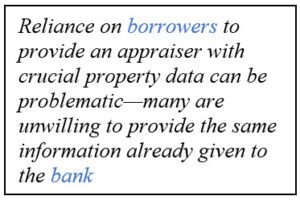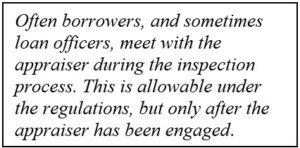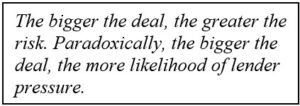Crucial Data
Most of the information analyzed in an appraisal report is gathered by the appraiser in his/her research. But some property-specific data must be provided to the appraiser by either the bank or the borrower.
 Appraisers have contracted deadlines, and when crucial property data cannot be obtained they will complete the report will without it. The resultant report is less credible/reliable for lending purposes.
Appraisers have contracted deadlines, and when crucial property data cannot be obtained they will complete the report will without it. The resultant report is less credible/reliable for lending purposes.
Crucial data includes any of the following that apply for a particular appraisal assignment.
- Purchase agreement and/or listing information
- Legal description that will be used in the mortgage documents
- Plans and specifications
- Cost estimate
- All leases – complete copies
- Income and expense statements for two years minimum
- Cross-use or parking agreements
- Franchise agreements
- Any other pertinent subject property information
Appraiser Independence
 Most banks have made great strides in fostering appraiser independence, separating the appraisal function from the lending groups and eliminating loan officer involvement from the engagement process. But there are some independence pitfalls beyond the bank’s internal processes.
Most banks have made great strides in fostering appraiser independence, separating the appraisal function from the lending groups and eliminating loan officer involvement from the engagement process. But there are some independence pitfalls beyond the bank’s internal processes.
Though independent, appraisers are customer-oriented. Instructions to amend the assignment in the course of an inspection, whether from the borrower or the lender, are not acceptable. But not all appraisers remember this. Sometimes such changes to the assignment appear to be credible modifications or additions, and are accepted/incorporated by the appraiser.
Appraiser independence is better maintained when the bank educates all approved appraisers that any instructions about an engaged appraisal assignment, including modifications or additions, are only legitimate if requested by someone in the bank’s appraisal function. Similarly, any involvement with the bank after the report is delivered must be limited to the reviewer.
Risk Assessment
One size does not fit all when it comes to banks and their collateral evaluation processes. Accordingly, the guidelines provide few specifics and focus instead on risk. The particular emphasis of the guidelines is risk to the institution—unique to the size, loan portfolio, credit culture, and footprint of the bank.
To comply with the guidelines, the appraisal function of any bank must have a codified process for identifying risk. When higher risk deals, markets, and properties are identified, this codified process should trigger stricter engagement and review processes.
Stricter engagement processes are two-fold: bidding of higher caliber, more qualified appraisers and a more comprehensive appraisal product. Appraiser selection must always match risk with appraiser competency. A skimpy appraisal product (with a single approach and much summarization) is acceptable for a lower risk transaction with a modest loan amount. But more research, analysis, and discussion is required when there is higher risk to the institution.
 In the review process, it is particularly important to match reviewer competency with risk to the institution. When a bank does not have an appraiser on staff, matching competency with the review assignment will sometimes require engagement of an outside review appraiser. The loan size or property complexity that would trigger outsourcing should be codified and the lending groups should be educated as to when additional review fees would be incurred.
In the review process, it is particularly important to match reviewer competency with risk to the institution. When a bank does not have an appraiser on staff, matching competency with the review assignment will sometimes require engagement of an outside review appraiser. The loan size or property complexity that would trigger outsourcing should be codified and the lending groups should be educated as to when additional review fees would be incurred.

Author:

Heidi Lee, MAI, MRICS, AI-GRS

